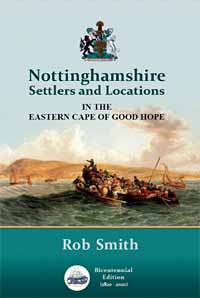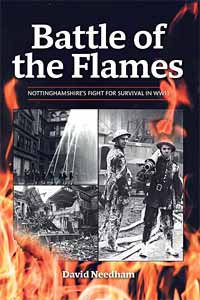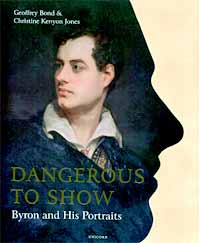Book reviews, Summer 2021
‘Nottinghamshire Settlers and Locations in the Eastern Cape of Good Hope’
Rob Smith has just published a work of 600 pages on The Nottinghamshire Settlers to the South African Cape during 1820.
A limited number of copies are available directly from Rob for £34 plus p&p. Please contact robsmith52@outlook.com

The middle months of 2020 were supposed to form a season of commemorations and family reunions marking the bicentennial of the story of the ‘1820 Settlers’. During 1820, over 90,000 people applied to join a state-led emigration plan to the southern tip of Africa with the intention of escaping poverty and starting a new life in a land that promised much. For the most part, the bicentenary celebrations were cancelled due to the pandemic, Rob Smith has published a wide-ranging study of the Nottinghamshire Settlers to mark the occasion.
4,000 applicants were accepted for the venture of which 200 originated from Nottinghamshire. The main party, led by surgeon Thomas Calton of Collingham, settled in a location they named Clumber in honour of the 4th Duke of Newcastle (the county’s Lord Lieutenant) who was their principal sponsor and fundraiser. Southwell magistrate, the Rev.J.T.Becher, and Newark-based Clerk of the Peace, Edward Smith Godfrey, managed the detailed arrangements and monitored the progress of the party. Sadly, Dr Calton died shortly after their landing, but despite this setback his party was statistically the most cohesive group of all. Furthermore, Clumber was, and is, situated at the heart of the settlement, as is the satellite district of Southwell named after the home town of settler Benjamin Keeton of the wider Becher family.
Their central locations and sustained residence has meant that the Nottinghamshire settlers have been heavily involved in all of the main successes and tribulations enjoyed and endured by the settlers. As such, their story is representative of the British settlers as a whole. They witnessed the last four of nine frontier wars spanning one hundred years, experienced the Great Flood of 1823, serious crop failures, a bizarre episode of tribal starvation, political neglect, and much more. More positively, they were engaged in significant cultural, scientific and industrial developments, spiritual progress, discoveries of diamonds and gold and advancements in the field of medicine.
This book covers some heartbreaking setbacks and spectacular successes, but a key intention has been to make some record of the ordinary daily lives of the people, particularly for their first two decades in the South African Cape. The research draws on regional and national archives and official documents in South Africa and England. Regular contact between Rob and the descendants of central characters now living in the UK, Africa and around the world, helping to reveal some of the feelings and attitudes of those descended from these intrepid pioneers. Rob has benefitted from meeting family historians, touring settler locations, and visiting museums and monuments during a hectic tour of the Eastern Cape in 2016. There he found a thriving community with a ‘can do’ attitude reflecting the spirit of communal determination inherited from their forebears.
Richard A. Gaunt
‘Battle of Flames : Nottinghamshire's fight for Survival in WWII’
David Needham
ISBN 978-1-909813-687, Bannister Publications Ltd. (Chesterfield, 2020), £17.99
(
https://www.bannisterpublications.com/product-page/battle-of-the-flames)

‘If the Battle of Britain was won by “The Few”, the Battle of the Flames was won by the many'. This is the opening sentence to the introduction to the book that David has compiled and written.
The ‘many’ were the ordinary people whose everyday jobs did not involve fighting fires or saving lives, but when the time came would step up to the mark and be counted. To these ordinary people the war was something they read about in the newspapers or they heard of on the wireless as they listened to the BBC over the airwaves. The war was seeing loved ones enlisting and going off to fight.
But, in 1940, the war suddenly became more real as it came to these shores, not from an invasion, but from the air as Hitler’s Luftwaffe carried out bombing raids on the south coast and later spreading to the industrial towns and cities across the country.These bombing raids would bring forth the ‘many’ as they came forward to play a vital role in this nation’s history as auxiliary fire fighters, ARP wardens, ambulance drivers and first aiders, many more roles would be filled as the war progressed by the ‘ordinary man and woman’.
Nottinghamshire air raids began in mid-August 1940 with various attacks on the city, however, it would be the air raid on the night of the 8/9th May 1941 that would see the city suffer its worst bombing and greatest loss of life. It would be on this night that the word ‘Blitz’ would be added to Nottingham when describing the events of the 8/9th May. During the night some of Nottingham’s major buildings would be struck by bombs and various incendiary devices. Across the city, buildings were destroyed and burned, from the university on Shakespeare Street, to the city centre and the Lace Market, out to the Co-operative Bakery on Meadow Lane. The destruction would spread across the perimeter of the city including Beeston, Sneinton, Carlton and West Bridgford. In total, during the night 424 high explosive bombs and 6,804 incendiary devices would rain from the sky. The death toll on that night was 160 men, women and children, with hundreds treated for injuries. The greatest loss of life was at the Co-operative Bakery (50) and the Dakeyne Street public air shelter (21).This air raid would not be the last, but none that followed would have the same devastating effect as that which took place in the early hours of the 9th of May 1941.
This book is the second edition of David’s original work, first published in 2009, timed to coincide with the 80th anniversary of the ‘Nottingham Blitz’. This new version explores in-depth the air raids, the destruction, the loss of life and the aftermath. The book (226 pages) has many new images with a large number in colour. For David, ex Divisional Officer of Nottinghamshire Fire & Rescue Service, what started as an article for the journal of the Nottinghamshire Fire and Rescue Service in 1990 was much more, especially when he started talking to the wartime veterans of the Fire Service and the Air Raid Precautions Service. A bigger picture began to be revealed, one that needed to be told.
To quote from David’s book: 'This is the story of the people of Nottinghamshire and the aerial war waged against them.’ For anyone like me, whose only knowledge of these events came from stories from my parents, the book is a fascinating and revealing read and a sad and tragic reminder of these dark days in Nottinghamshire’s wartime history. A fitting tribute to the ‘many’.
Kevin Powell
Dangerous to show: Byron and His Portraits
Geoffrey Bond and Christine Kenyon Jones
(London, Unicorn, 2020) ISBN 978-1-912690-71-8

I wonder how many Thorotonians have had their portrait painted? Today it is regarded as somewhat pretentious, but acceptable in some contexts such as a retirement gift from colleagues. Before the camera came into vogue the way to record one’s image was via a portrait or, in Byron’s case, portraits. In this superb book by Geoffrey Bond and Christine Kenyon Jones the Byron portraits are reproduced in full colour and discussed in detail. We learn about Byron’s own view of the images, which ones are in public or private ownership, which were painted from life, which were painted after his death, copies, engravings, and many more subjects, quite apart from issues of accuracy and the extent to which the artist could be persuaded to make changes - today’s Photoshop! There are portraits which might be Byron, and others said to be him which may not be. And then there were John Murray’s marketing tools. To sell Byron’s first great poem, Childe Harold, Murray wanted to add a portrait to help the second and subsequent print runs. Byron initially objected but eventually came to accept Murray’s viewpoint. Not everyone appreciated this exposure of the poet: Lady Liddell, on spotting Byron in Rome in 1817, covered her daughter’s eyes and warned her ‘Don’t look at him. He is dangerous to look at’.
The central focus of this book is the portraits of Byron dating from his childhood (chapter 1), his early years of fame (chapter 2), 1813-16 (chapter 3) and two chapters (4 and 5) on his years in Italy and Greece (1816-24). A final chapter is entitled ‘Imagining Byron’ and looks at many of the images produced after he died including statues, films, satirical prints, snuff boxes and medallions. It includes Max Beerbohm’s representation of what Byron might have looked like had he lived longer (p. 114). Each chapter looks at the portraits from the period discussing both the originals, and copies. The images are dated and engravings and other reproductions discussed. Variations are noted, and the impact they had on the image, and the date when it first came to public view. Of course many of the images are well known and have been reproduced numerous times.
Others have long been in private hands and are therefore less accessible, although many of them were brought together for an exhibition at the National Portrait Gallery in 2002-3. Byron used an engraving by Henry Meyer for members of his fan club, sending prints to satisfy their curiosity in the manner of a modern List A celebrity. Perhaps the most interesting chapter, at least to this reader, is chapter 3 which is entitled ‘Establishing “brand Byron”’. It covers the most famous images of Byron, notably Thomas Phillips’ oil paintings of 1813-14. The original Byron in Albanian costume now hangs in the British Ambassador’s residence in Athens, and an 1835 copy is now in the National Portrait Gallery.
If you are interested in Byron, this book is for you, and if you are interested in portraiture this is your book. Byron lived an extraordinary life, and died relatively young, and yet there was ‘time a plenty’ for numerous portraits and images to be produced. The book is a tour de force and reflects the authors’ knowledge of, and enthusiasm for, their subject
John Beckett